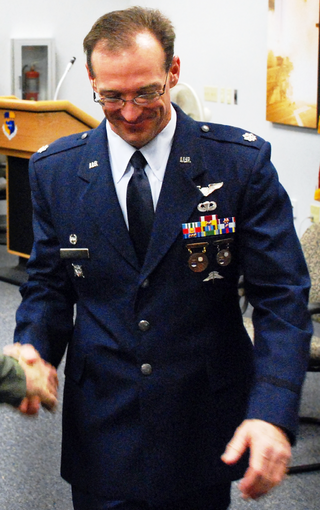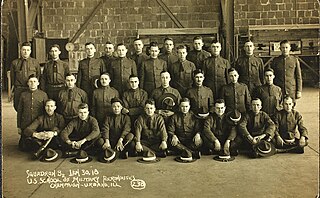
A flight surgeon is a military medical officer practicing in the clinical field of aviation medicine. Although the term "flight surgery" is considered improper by purists, it may occasionally be encountered.

Robert Lee Stewart is an American retired military officer and NASA astronaut who was a brigadier general of the United States Army.

The United States Astronaut Badge is a badge of the United States, awarded to military and civilian personnel who have completed training and performed a successful spaceflight. A variation of the astronaut badge is also issued to civilians who are employed with the National Aeronautics and Space Administration as specialists on spaceflight missions. It is the least-awarded qualification badge of the United States military.
An aviator badge is an insignia used in most of the world's militaries to designate those who have received training and qualification in military aviation. Also known as a pilot's badge, or pilot wings, the aviator badge was first conceived to recognize the training that military aviators receive, as well as provide a means to outwardly differentiate between military pilots and the “foot soldiers” of the regular ground forces.
The Observer Badge is a military badge of the United States armed forces dating from the First World War. The badge was issued to co-pilots, navigators, and flight support personnel who had received a variation in the training required for the standard Pilot's Badge. The Observer Badge survived through the Second World War and into the 1950s, at which time the concept of an Observer Badge was phased out in favor of the modern Aircrew Badge and Navigator-Observer Badges. In addition to wings for Naval Aviators and Naval Flight Officers, the United States Navy still maintains an "Observer Badge" which is issued to flight-qualified mission specialists, such as a select number of meteorologists and intelligence officers in both the U.S. Navy and U.S. Marine Corps. The U.S. Air Force awards its USAF Observer Badge, which is identical to the USAF Navigator Badge, to Air Force officers who have qualified as NASA Space Shuttle Mission Specialists, have flown an actual mission aboard the shuttle and/or the International Space Station and who are otherwise not previously aeronautically rated as an Air Force pilot or navigator.
The Glider Pilot, Liaison Pilot, and Service Pilot badges were qualification badges of the United States Army Air Forces issued during the years of World War II to identify a rating in one of three specialized, limited-duty pilot categories whose selection and training differed from that of the traditional military pilot.
The Naval Flight Officer insignia is a breast insignia of the United States military which is awarded to those aviators of the Navy, Marine Corps and Coast Guard who have qualified as Naval Flight Officers (NFO) based on successful completion of flight training. The insignia is similar in design to the Naval Aviator insignia, consisting of a pair of golden wings, a shield, and crossed anchors.

A United States Aviator Badge refers to three types of aviation badges issued by the United States Armed Forces, those being for Air Force, Army, and Naval aviation.
A naval flight officer (NFO) is a commissioned officer in the United States Navy or United States Marine Corps who specializes in airborne weapons and sensor systems. NFOs are not pilots (naval aviators), but they may perform many "co-pilot" or "mission specialist" functions, depending on the type of aircraft. Until 1966, their duties were performed by both commissioned officer and senior enlisted naval aviation observers (NAO).

The Air Force Reserve Officers' Training Corps (AFROTC) is one of the three primary commissioning sources for officers in the United States Air Force and United States Space Force, the other two being the United States Air Force Academy (USAFA) and Air Force Officer Training School (OTS). A subordinate command of the Air University within the Air Education and Training Command (AETC), AFROTC is aligned under the Jeanne M. Holm Center for Officer Accessions and Citizen Development at Maxwell AFB, Alabama. The Holm Center, formerly known as the Air Force Officer Accession and Training Schools (AFOATS), retains direct responsibility for both AFROTC and OTS.

Badges of the United States Air Force are specific uniform insignia authorized by the United States Air Force that signify aeronautical ratings, special skills, career field qualifications, and serve as identification devices for personnel occupying certain assignments.

Insignia and badges of the United States Marine Corps are military "badges" issued by the United States Department of the Navy to Marines who achieve certain qualifications and accomplishments while serving on both active and reserve duty in the United States Marine Corps.

A bombardier or bomb aimer is the crew member of a bomber aircraft responsible for the targeting of aerial bombs. "Bomb aimer" was the preferred term in the military forces of the Commonwealth, while "bombardier" was the equivalent position in the United States Armed Forces.

An aircrew flying badge is the badge worn on the left breast, above any medal ribbons, by qualified aircrew in the Royal Air Force, Royal Navy, British Army, Indian Air Force, Pakistan Air Force, Royal Canadian Air Force, Royal Australian Navy, Australian Army, Royal Australian Air Force, Royal New Zealand Air Force, South African Air Force and Sri Lanka Air Force. An example of a real pilot brevet is as opposite:
The Aircrew Badge, commonly known as Wings, is a qualification badge of the United States military that is awarded by all five branches of armed services to personnel who serve as aircrew members on board military aircraft. The badge is intended to recognize the training and qualifications required by aircrew of military aircraft. In order to qualify as an aircrew member and receive the Aircrew Badge, such personnel typically undergo advanced training in aircraft in-flight support roles.

A Weapon Systems Officer (WSO), nicknamed "Wizzo", is an air flight officer directly involved in all air operations and weapon systems of a military aircraft.
A Combat Systems Officer (CSO) is a flight member of an aircrew in the United States Air Force and is the mission commander in many multi-crew aircraft. The combat systems officer manages the mission and integrates systems and crew with the aircraft commander to collectively achieve and maintain situational awareness and mission effectiveness. CSOs are trained in piloting, navigation, the use of the electromagnetic spectrum, and are experts in weapon system employment on their specific airframe. Aircrew responsibilities include mission planning, mission timing, weapons targeting and employment, threat reactions, aircraft communications, and hazard avoidance.

Michael Timothy "Bueno" Good is a retired NASA astronaut, engineer and retired commissioned officer in the United States Air Force, holding the rank of Colonel. Mike Good flew aboard Space Shuttle Atlantis for its STS-125 mission. STS-125 was the final Hubble Space Telescope servicing mission. Good flew as mission specialist 2 to the International Space Station on STS-132.

U.S. Air Force aeronautical ratings are military aviation skill standards established and awarded by the United States Air Force for commissioned officers participating in "regular and frequent flight", either aerially or in space, in performance of their duties. USAF aeronautical badges, commonly referred to as "wings" from their shape and their historical legacy, are awarded by the Air Force in recognition of degrees of achievement and experience. Officers earning these badges and maintaining their requirements are classified as rated officers and receive additional pay and allowances.

The Flying/Aviation Cadet Pilot Training Program was originally created by the U.S. Army to train its pilots. Originally created in 1907 by the U.S. Army Signal Corps, it expanded as the Army's air assets increased.













